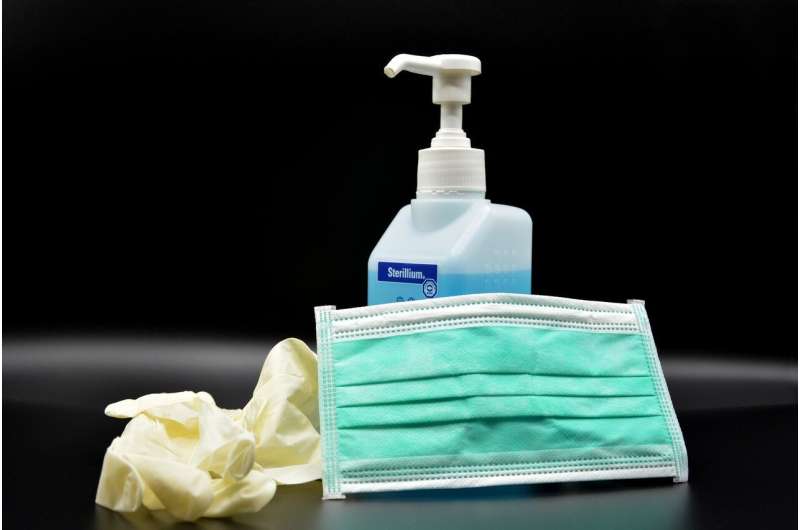This article has been reviewed according to Science X's editorial process and policies. Editors have highlighted the following attributes while ensuring the content's credibility:
fact-checked
peer-reviewed publication
trusted source
proofread
Public health interventions prevented transmission within Boston University of most SARS-CoV-2 cases, finds study

SARS-CoV-2, the causative agent of COVID-19, began impacting the U.S. in March 2020 with many schools and universities shifting to remote education by early April 2020 in response to the public health emergency.
Despite public health interventions (increased ventilation, masking policies, surveillance testing, contact tracing of confirmed cases and quarantine procedures for infected students, faculty and staff) there were still concerns that institutes of higher education would be a hotbed of transmission, including transmission from students into surrounding communities.
But, were these fears warranted?
A new study from Boston University's COVID Clinical Testing Lab and Contract Tracing along with researchers from Boston University Chobanian & Avedisian School of Medicine, has found that public health interventions prevented transmission for most SARS-CoV-2 introductions at BU, with only two major outbreaks within the university identified from January to May 2021. These findings appear online in the Journal of Infectious Diseases.
"We found that genetically linked cases overlap with outbreaks identified by contact tracing; however, they persisted in the university population for fewer days and fewer rounds of transmission than originally estimated via contact tracing," explains corresponding author John Connor, Ph.D., associate professor of microbiology at the School of Medicine.
"This underscores the effectiveness of test-trace-isolate strategies in controlling undetected spread of emerging respiratory infectious diseases. These approaches limit transmission from those people outside the university as well as those who caught the disease from someone within the campus community," adds Connor who also is a researcher at the Boston University National Emerging infectious Diseases Laboratories.
Connor and his team hypothesized that the viral genomics data would support contact tracing's finding that most SARS-CoV-2 infection on campus were singular events not linked to intra-campus transmission chains. Additionally, they aimed to identify any large outbreaks among members of the campus community and align genetically identified outbreaks with cases linked via contact tracing.
In April 2020, Boston University enforced weekly surveillance testing, social distancing, masking and prohibited school-sanctioned social events. Individuals who tested positive were isolated for ten days by moving into on-campus isolation housing or isolating at private off-campus residences.
To track and limit infection spread, the university performed comprehensive bi-directional contact tracing to identify likely transmission pathways through interviews of all test-positive individuals and known contacts. This information was then coupled with viral genomic sequencing for both asymptomatic and symptomatic cases to confirm likely transmission events and spur re-investigation if genomic data suggested additional links.
Viral genomic sequencing captured 767 unique SARS-CoV-2 genotypes on the BU campus during the spring 2021 semester. Of these, they observed 696 genotypes (91%) only once, making it unlikely that they established on-campus transmission chains. The few genotypes with multiple observations usually showed transmission bubbles of less than five individuals; only seven genotypes (approximately 1%) included more than five samples.
According to the researchers, these findings highlight the ability of systematic testing, tracing, and quarantine approaches to limit respiratory transmission in a complicated urban environment with repeated introduction of SARS-CoV-2 from outside sources.
The researchers believe these findings have implications for not only SARS-CoV-2 but also other respiratory diseases and show what one can expect in future outbreaks if responses are limited and lack effective pharmacological interventions. Vaccination was unavailable to most BU students and staff until March 2021, so infection control measures were limited to mask mandates, symptom monitoring, surveillance testing, and isolation following a positive test.
"Our analyses support the hypothesis that systematic interventions, such as population-level test-trace-isolate strategies, are highly effective in limiting respiratory infection transmission, even in the presence of continual importation of disease from outside the university population," said first author Jackie Turcinovic, a Ph.D. candidate in the Connor lab.
More information: Jackie Turcinovic et al, Transmission dynamics and rare clustered transmission within an urban university population before widespread vaccination, The Journal of Infectious Diseases (2023).




















